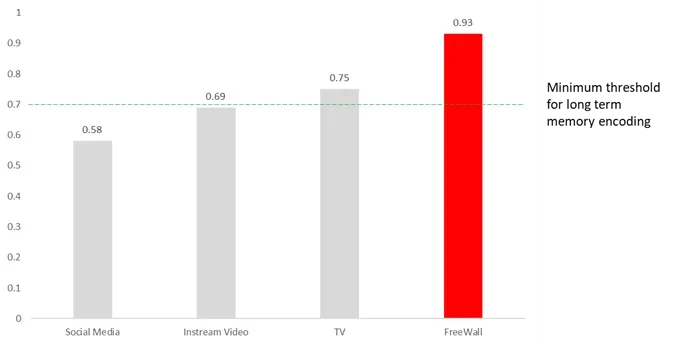
How to measure ad recall lift
What is ad recall?
In today’s information age, we’re bombarded with stimuli. It’s estimated that the average person sees between 50-400 ads per day (although numbers between 6000-10000 are often quoted, their sources are difficult to verify). This sheer volume of advertising begs the questions:
- How many of these ads do your target audience actually notice?
- More importantly, how many of those ads are remembered and ultimately trigger action?
Enter ad recall, also known as ad recognition or brand recall. This metric is a measure of how memorable an advert is to an audience. It serves as a valuable tool for advertisers and agencies to assess campaign effectiveness by measuring how well viewers remember or recognize the advert after seeing it.
Essentially, ad recall evaluates whether an ad leaves a lasting impression on the audience’s memory, and whether the audience can clearly associate it with the relevant brand and/or product that’s being promoted.
This guide will take you through 5 key steps to ensure you can both measure and boost your ad recall:
How to measure ad recall lift
Ad recall is typically measured via surveys or research studies. In these studies, respondents who have been exposed to an advertisement are asked questions about their ability to recall specific details of the ad, such as the brand, product, message, visuals, or any other key elements. The goal of the research is to determine the percentage of respondents who can accurately recall the ad and its associated brand.
High ad recall percentages indicate that the advertisement has successfully captured the attention of the audience and left a strong impression. This suggests that the ad has effectively communicated both its key message and brand identity. Advertisers often use ad recall as an important performance indicator to evaluate the impact and effectiveness of their advertising campaigns.
Ad recall can also be determined instantly by certain ad formats if you are working with interactive ad unit options such as YouGov FreeWall®.
Why might your ad recall be low?
The first step towards increasing your ad recall lift is to ensure your ads are noticeable and won’t be missed.
Ad blindness:
Overexposure to ads, especially if they’re repetitive formats or those in a location they commonly associate as serving ads, can lead to conscious or subconscious ignoring by viewers.
Viewability issues:
Even if your ad successfully loads and registers an impression, it doesn't guarantee being seen by your target audience.
Attention:
Your ad might be technically viewable, however this doesn’t mean that an audience has paid any attention to it whatsoever.
Fraud:
Unfortunately, online the views or clicks of an online ad can also be artificially inflated. In 2022, this resulted in the loss of $68 billion globally in digital ad spend.
How to get your ad noticed
Now that we’ve identified potential roadblocks, are strategies to ensure your ads cut through the noise, guaranteeing viewability and attention:
High impact formats
Standing out from competition will help you to gain higher share of voice and increase the likelihood of being seen, so it’s important to use an ad format that grabs or even demands attention.
Powerful creative and messaging
Some of the most memorable ads in recent history owe their success to compelling creative. Think Cadbury’s – Gorilla, Compare the Meerkat and Specsavers - Should’ve. One way to ensure this is testing your ad concepts with your target audience beforehand.
How to create a memorable ad
While ensuring ad viewability is essential, the true goal of advertising lies in creating lasting impressions that drive brand recall. Here are four key things that should be top of mind when striving to create memorable ads:
Emotional resonance
Tap into viewers' emotions to create a lasting connection. Humor, nostalgia, or heartwarming stories can leave a significant impact. Why do you think the Coca-Cola Christmas ad is so highly anticipated each year?
Unique selling proposition
Clearly communicate your brand’s differentiating factor and what sets it apart from competitors. This helps viewers remember your brand when considering a purchase.
Simplicity is key
Avoid being overly complex or cluttered. Keep your message clear, concise, and easy to understand for maximum memorability. We can’t expect consumers to remember something they don’t understand.
Storytelling
Humans are hardwired for stories. Capture your target audience’s attention with a compelling narrative that resonates with their wants and needs.
YouGov FreeWall®: Enhancing recall and engagement
Creating memorable ads is easy when you use an interactive format like YouGov FreeWall®. It’s an innovative ad format that goes beyond simply grabbing attention. It actively engages viewers, boosting ad recall and brand messaging effectiveness. Here’s how:
- Guarenteed attention: Unlike traditional ads that may be scrolled past, YouGov FreeWall® drives active viewer interaction with your brand.
- Interactive quizzing: You can quiz your customers about the ad they’ve just seen by posting a question they must answer correctly to unlock the content behind the FreeWall®. This not only reinforces your brand’s key messaging, but also educates consumers about your brand, product or service’s USP.
- Premium publisher context: Freely displayed within reputable publishers’ content, YouGov FreeWall® ads benefit from operating in a trusted environment with higher engagement rates.
- Measurable uplift: Brand studies with a control vs exposed sample showed YouGov FreeWall® delivers on average a brand recall uplift of 80%.
YouGov FreeWall® is a very fast way of surveying people who have been exposed to your ad, as you serve it to them.
By confirming their understanding, the reader is much more likely to remember the key point of your advertisement and then act on it at a later date.
Long term memory encoding
Long term memory encoding is a vital neuroscience metric, as its correlation with decision making and purchase intent makes it the primary indicator of communication effectiveness.
In order for people to remember something, the memory encoding response has to get over a certain threshold. A study conducted with Neuro Insight and Sky found that FreeWall® advertising triggers higher levels of memory encoding responses compared to traditional ads, this demonstrates that the FreeWall® format effectively encodes information in viewers' long-term memory, increasing the likelihood of recall.

YouGov FreeWall® client success stories:
Numerous brands have leveraged YouGov FreeWall® to achieve impressive results:
- One of Britain’s biggest commercial broadcasters: 85% brand recall uplift
- UK’s largest train operator: 65% average brand recall uplift across their recent campaigns
- Premium streaming platform: 86% brand recall uplift
- Leading investment platform: 71% brand recall uplift
